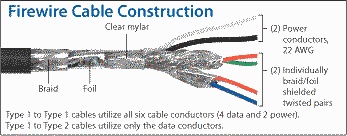FireWire is a high-speed serial communication standard defined by IEEE 1394. It was originally designated by Apple, where the name “FireWire” came from. Sometimes it has also been referred to as iLINK (a Sony branding initiative). With a 400 Mbps bandwidth, FireWire can be used to connect high-speed devices such as video camcorders, audio recorders, and external storage devices. The theoretical limit for the bandwidth is 400 Mbps (or 800 Mbps with FireWire 800), although actual throughput is slightly slower. A FireWire bus is self-powered (FireWire peripherals can derive power from the bus, eliminating the need for a separate power cord, only 6 pin and 9 pin connectors carry the power). The bus configures itself automatically (not requiring device IDs or terminators); and it is hot-pluggable (one can connect and use a FireWire peripheral via a simple modular connector without having to restart the computer).
FireWire replaced SCSI as Apple’s standard high-speed interface beginning with the blue G3 PowerMac; PCI cards and PC Cards can bring FireWire ports to PCI PowerMacs and PowerBook G3’s, respectively.
FireWire Digital Video (DV) camcorders, digital still cameras, and analog-digital video converters are already available, with mass storage devices (hard drives, magneto-optical drives, high-capacity removable drives, tape drives, and CD/DVD drives) and printers mostly still to come.

| Type 1: Typically found on Computers and Hubs. 6 Pin: |
 |
 |
| Type 2: Typically found on peripheral devices. 4 Pin: |
 |
 |
| Type B: 800Mbps, Must be 9 pin at both ends to support 800Mbps. 9 Pin: |
 |
 |
Devices on the bus are Hot-Swappable.
| Up to 63 devices can be connected using hubs in a distributed Star Topology. The maximum cable length for any branch is 4.5 meters. A second hub can be connected to the first hub to add more ports or branches to the distributed star or tree topology. |  |
| In a Bus or Daisy Chain Topology, up to 16 devices can be chained. The total cable length from end to end can’t exceed 72 meters. |  |
Transmitting data over CAT 5 cable allows data at 100Mbps to travel 100 Meters (1394b).
PCMCIA FireWire cards do not provide power so peripherals like the iPod would need their own external power supply.





